The death toll of the First World War was unprecedented. The war ignited a sense of national pride and a move to memorialize those who had died emerged throughout the community.
In March 1919 the Amputation Club of BC sent a letter to the Maple Ridge council asking for an honour roll of Maple Ridge soldiers who had died in the First World War. The names were to be published in The Gold Stripe No. 2: A Tribute to the British Columbia Men who have been Killed, Crippled and Wounded in the Great War: A Book of War, Peace and Remembrance. The request was referred by council to the Returned Soldiers Reception Committee. Maple Ridge Councillors Lilley and Pope went to Vancouver in April and selected a drawing and provided the Gold Stripe publisher with a list of names. The cost for their page was $25 (about $400 in 2023 money).[1] The book was published in May 1919 with the proceeds going to the Amputation Club of BC.
The 23 May 1919 Abbotsford Post noted that when the Maple Ridge Returned Soldiers Reception Committee consisting of Reeve William Henry Ansell, Councillors James Dale, Ernest Edgar Adair, John Lilley, and Edmund Pope met in April to discuss an honour roll or tablet; they thought it would be “advisable to have two ladies on the committee.” The Returned Soldiers Reception Committee communicated with the Red Cross, the War Relief Societies of the district, and the Women’s Institute of Port Haney and requested one representative from Port Haney and one from Port Hammond. Subsequently, Margaret Simson and Isabel Tapp “presented credentials from the Red Cross and War Relief Societies, and the Women’s Institute, and took their seats with the committee.”[2] Simson represented Port Haney and Tapp represented Port Hammond. By June 1919 plans were already underway by the Returned Soldiers Reception Committee to create a memorial tablet and monument. Council passed the motion at their 7 June 1919 meeting.
Several of the members of the committee had family members who had enlisted or worked in munitions including Lilley, Pope, Simson, and Tapp.
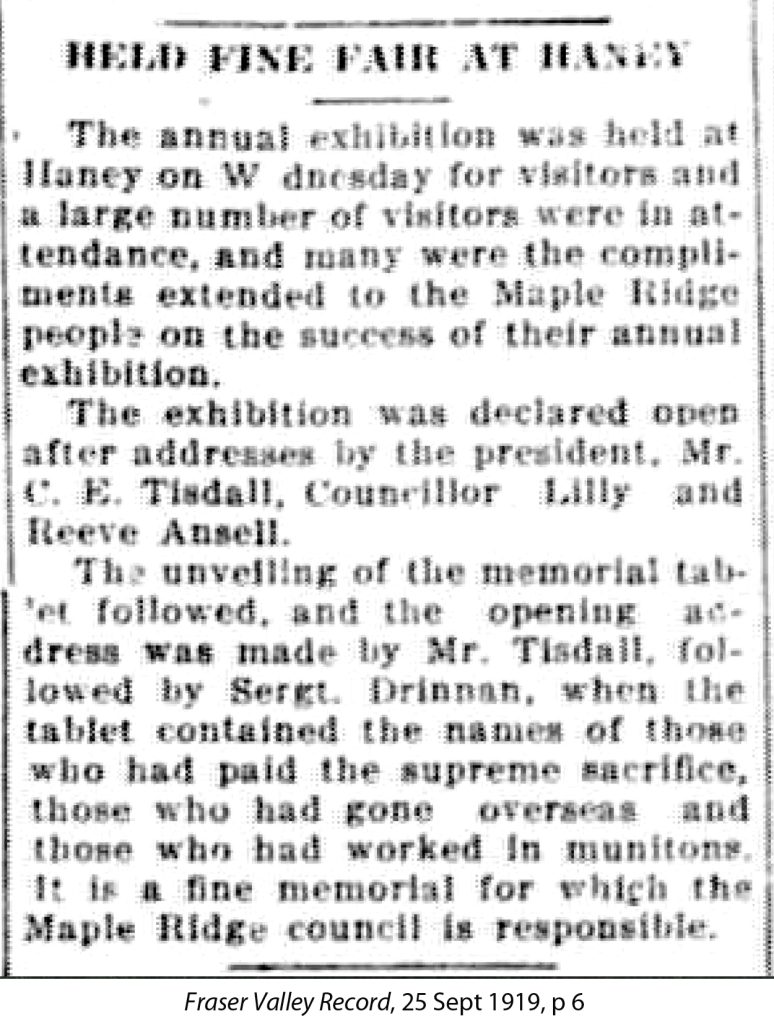
The 10 July 1919 Fraser Valley Record reported that the Returned Soldiers Reception Committee planned to hold a public meeting on July 19th at the Municipal Hall in Haney to consider the erection of a suitable monument and devise means to raise the necessary funds. The newspapers did not record any fundraising efforts. The bronze memorial tablet created by O.B. Allan Jewellers at a cost of $317, (about $5,000 in 2023 money) was unveiled at the Haney fall fair in September 1919.[3] “The tablet contained the names of those who had paid the supreme sacrifice, those who had gone overseas and those who had worked in munitions.”[4]
By 1922, the existence of the bronze memorial tablet had almost been forgotten. The Haney Women’s Institute wrote a letter to council requesting that the bronze tablet “no longer be concealed in the municipal vault but be erected in some public place, suggesting the new High School for consideration, but refraining from any attempt to influence the Council.”[5] Members of council stated that the tablet was in the vault for safety against fire with the intention to place it at the new municipal hall. Further action was referred to the Returned Soldiers Committee.
In February 1923 Mr. Lilley of the Returned Soldiers Committee reported to council that some mistakes had been made in the past regarding the monument. Mr. John Laity “explained it did not seem proper that this tablet with the names of the living as well as those of the dead should be placed together in a memorial monument for those who had died in the war.” The committee proposed a war monument in the form of a Celtic cross with the names of 36 Maple Ridge soldiers who had died in the First World War. They suggested that the monument be installed in the cemetery rather than the municipal hall or the school grounds where people would be “occupied with worldly matters.” “In the sacred surrounding of the graveyard they realized the solemnity and their minds were attuned to higher things.” [6]
The committee reassured the council that the names of the soldiers were soldiers of Maple Ridge and had been carefully scrutinized and every effort had been taken to be accurate. Council accepted the report and granted $1,500 for the monument (about $25,600 in 2023 dollars).[7]
On 23 May 1923 almost 1,000 citizens of Maple Ridge assembled to witness the unveiling of the cenotaph at the entrance of the cemetery. Some of the members of the Memorial Committee were present: President John Lilley; Secretary, Edmund Pope; EE Adair; Mrs. Simson; and Mrs. Tapp. The over four metre high, light grey granite was provided by Nelson Island for the Celtic Cross. Art Monument Co. of Vancouver executed the memorial, designed by Captain Thornton Sharp. Four large boulders were placed on the corners with the name and date of key battles from the First World War: Ypres 1915; Somme 1916; Vimy Ridge 1917; and Amiens 1918.
The Royal Canadian Legion was established in 1925. The Maple Ridge Ladies Auxiliary Service club was established in May 1927 followed by Maple Ridge Branch 88 in June 1927. The Legion took over the planning of Armistice Day commemorations and gradually the maintenance of the cenotaph became the responsibility of the Legion instead of the municipality.
The weight of the memorial had caused it to tilt and crack so the base of the cenotaph was replaced in July 1939.[8]
In November 1945 Maple Ridge branch of the Canadian Legion announced their intention to “place a suitable tablet in an appropriate place of honour of those who gave their lives in the last war.” The Legion published a proposed list of names in the November 9th edition of The Gazette. They outlined that “it was not necessary that the service man should have resided in Maple Ridge or Pitt Meadows prior to enlistment, but they would like to include those whose relatives” were now residents.
![Cenotaph in its original location at the entrance to the Maple Ridge cemetery. 1936. [P01044]](http://mapleridgemuseum.org/wp-content/uploads/2019/08/P01044-777x1024.jpg)
An editorial in the 17 November 1950 Gazette asked the Canadian Legion, Maple Ridge Council and the Board of Trade to consider the relocation of the cenotaph to the new civic centre. The editorial suggested that public fundraising could be considered to cover the “cost of moving the cenotaph, lay out the grounds surrounding it, and complete the inscription of the veterans who lost their lives in the last war, on the pillar.”[9]
In 1952 the Maple Ridge Branch 88, Canadian Legion, proposed relocating the cenotaph to a more central location on the civic grounds. As well, council felt that parking was needed for the church near the cemetery. The Haney Women’s Institute initially opposed the relocation.[10] The 19 January 1953 Council Minutes state that the Haney Women’s Institute “had now withdrawn their protest regarding the moving of the Cenotaph.”
Burrell Bros. constructed a new cement base with steps leading to a field for memorial gatherings. The civic site included a garden.
In November 1966 two stones were added to the area surrounding the cenotaph inscribed with France, Germany, Italy, Hong Kong, and Korea as reminder of countries where battles were fought.[11]
In 2000 as part of the Legion’s Millennium project twenty-seven names were added to the north and south sides of cenotaph. The research was done by Jeff Davis.[12]
In 2001 the cenotaph moved to its current location at Memorial Peace Park.[13]
Memorials
Various other plaques and memorials were created throughout Maple Ridge and Pitt Meadows. Honour rolls list names of people who served including nurses, munition workers, and home defenses.
Maple Ridge

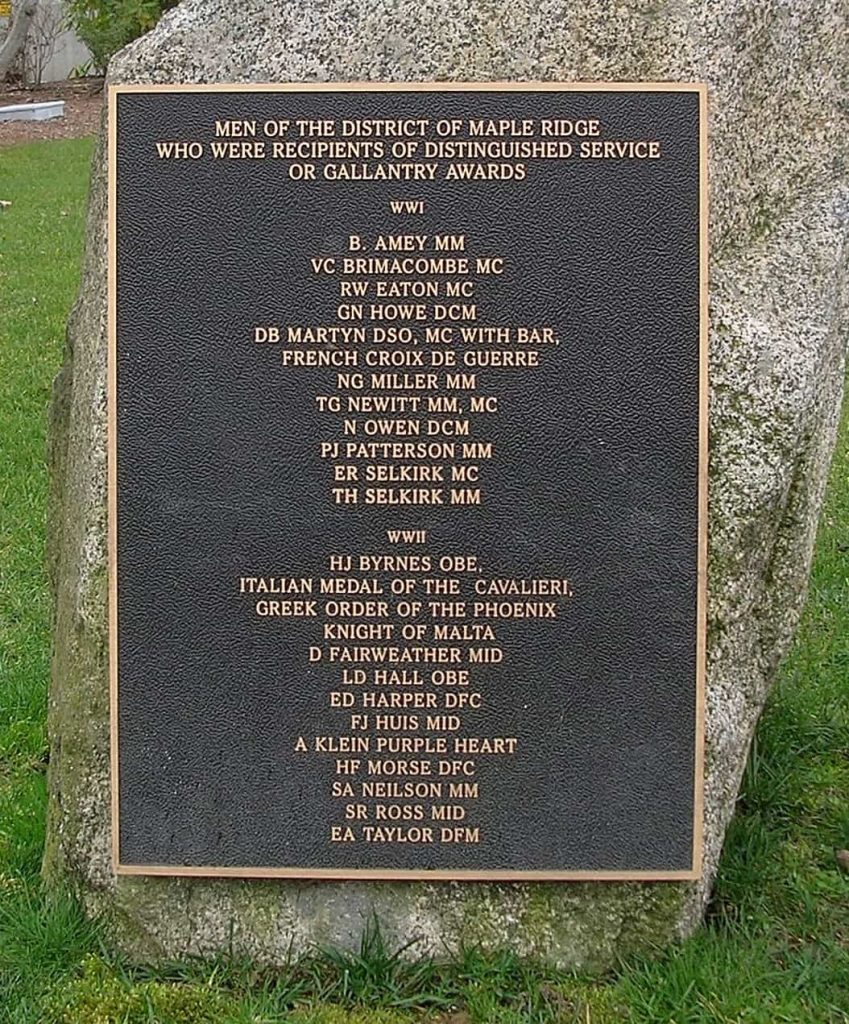
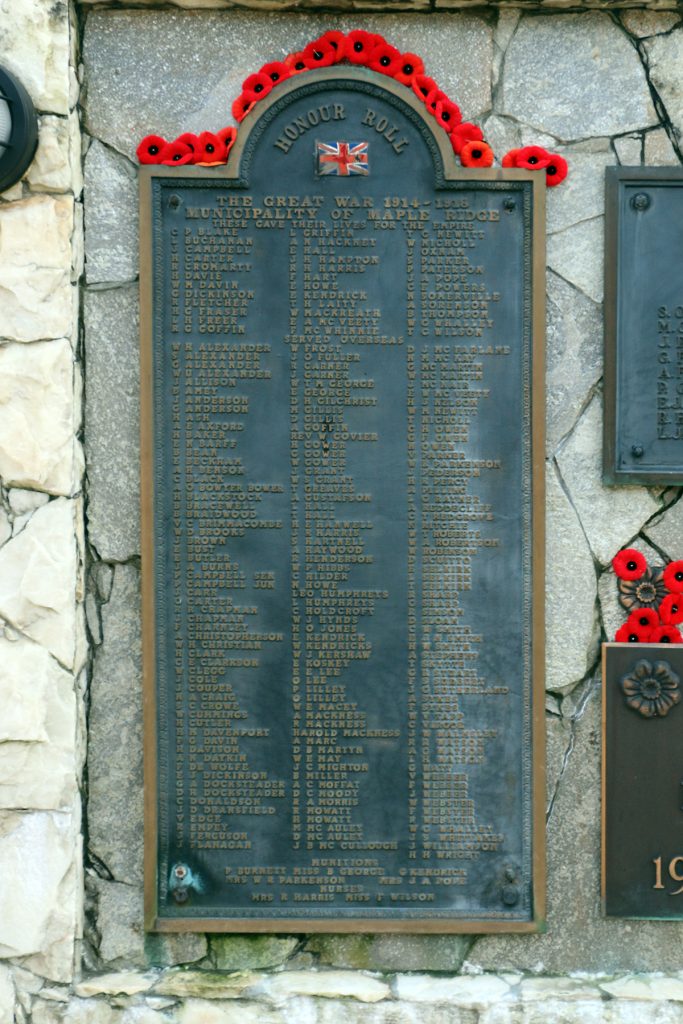
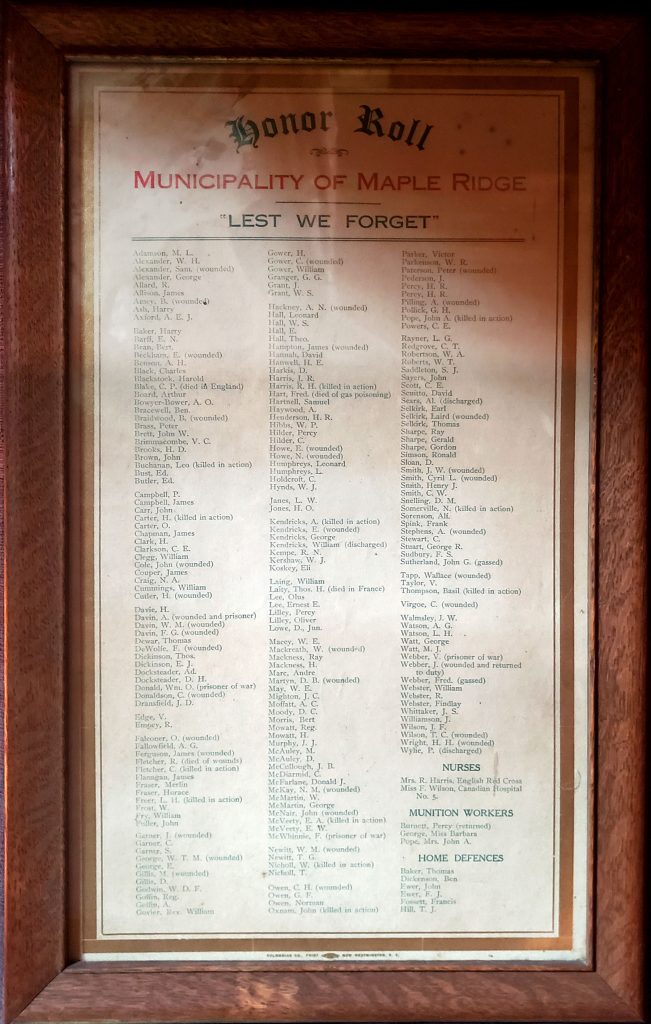
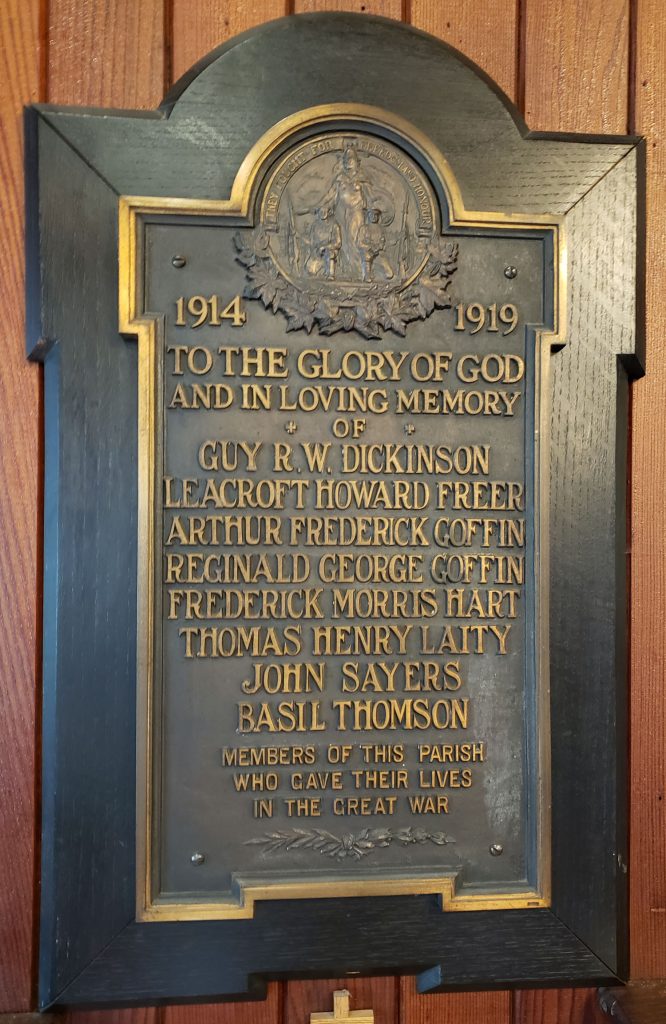
Whonnock, Maple Ridge, BC
In 1919 the “Ladies Hall” in Whonnock was dedicated to the memory of the soldiers from the area and renamed the “Whonnock Memorial Hall.”[14] In 1921 a brass memorial plaque was attached above the main entrance of the hall. In 1988 the plaque was moved to its present place in front of the Whonnock Lake Centre. The In Memory of Those Who Fell” Whonnock Notes No. 22 – Spring 2016 contains information about the soldiers whose names are on the memorial plaque.
Whonnock In Memory of Those Who Fell, First World War; Location: Whonnock Lake Centre, 27871 – 113th Avenue, Whonnock, Maple Ridge, BC
In Loving Memory of Arthur Norman Hackney; Location: Holy Spirit Anglican Church, 27123 River Road, Whonnock, Maple Ridge, BC
In Memory of Robert Hugh Harris; Location: Holy Spirit Anglican Church, 27123 River Road, Whonnock, Maple Ridge, BC
Whonnock’s Roll of Honour in the C.E.F.; Location Unknown
For King and Country. Members of St John the Evangelist; Second World War; Location: Holy Spirit Anglican Church, 27123 River Road, Whonnock, Maple Ridge, BC
PITT MEADOWS, BC
Pitt Meadows Cenotaph; Location: Spirit Square, 12007 Harris Road, Pitt Meadows, BC
Honour Roll Pitt Meadows Municipality; Location: Pitt Meadows Community Church, 12109 Harris Road, Pitt Meadows, BC
[1] $1 CDN in 1919 converts to approximately $16.19 in 2023 money. “Inflation Calculator,” Bank of Canada, accessed July 15, 2023, http://www.bankofcanada.ca/rates/related/inflation-calculator/.
[2] “Maple Ridge Memorial Committee.” Abbotsford Post, May 23, 1919, 6.
[3] Council Meeting Minutes, December 6, 1919. Second source: “Inflation Calculator,” Bank of Canada, accessed July 15, 2023.
[4] “Held Fine Fair at Haney” Fraser Valley Record, September 25, 1919, 6.
[5] “Municipal Parliament”. Gazette. November 9, 1923, 1.
[6] “Town Parliament: Our Heroes To Have a Fitting Monument”. Gazette. February 8, 1923, 4–5.
[7] $1,500 CDN in 1923 converts to approximately $25,597.83 in 2023 money. “Inflation Calculator,” Bank of Canada, accessed July 15, 2023, http://www.bankofcanada.ca/rates/related/inflation-calculator/.
[8] Gazette, July 28, 1939, 6.
[9] “Cenotaph Committee Appointed”, The Gazette, November 21, 1947, 1.
[10] “Haney WI Hearing Awaited.” Maple Ridge-Pitt Meadows News, December 11, 1952, 15.
[11] “Stones Marking Overseas Service” Gazette, November 16, 1966, 1, 3 and Second Edition, 1, 5.
[12] “Names added to cenotaph,” The Times, August 29, 2000.
[13] Nickols, Sheila. “New point of interest for familiar monument,” Maple Ridge – Pitt Meadow News, January 22, 2003.
[14] “Ladies Club Minutes.” Whonnock Notes No. 16, Winter 2006/2007, 38.
(Updated 08-Feb-2024)
